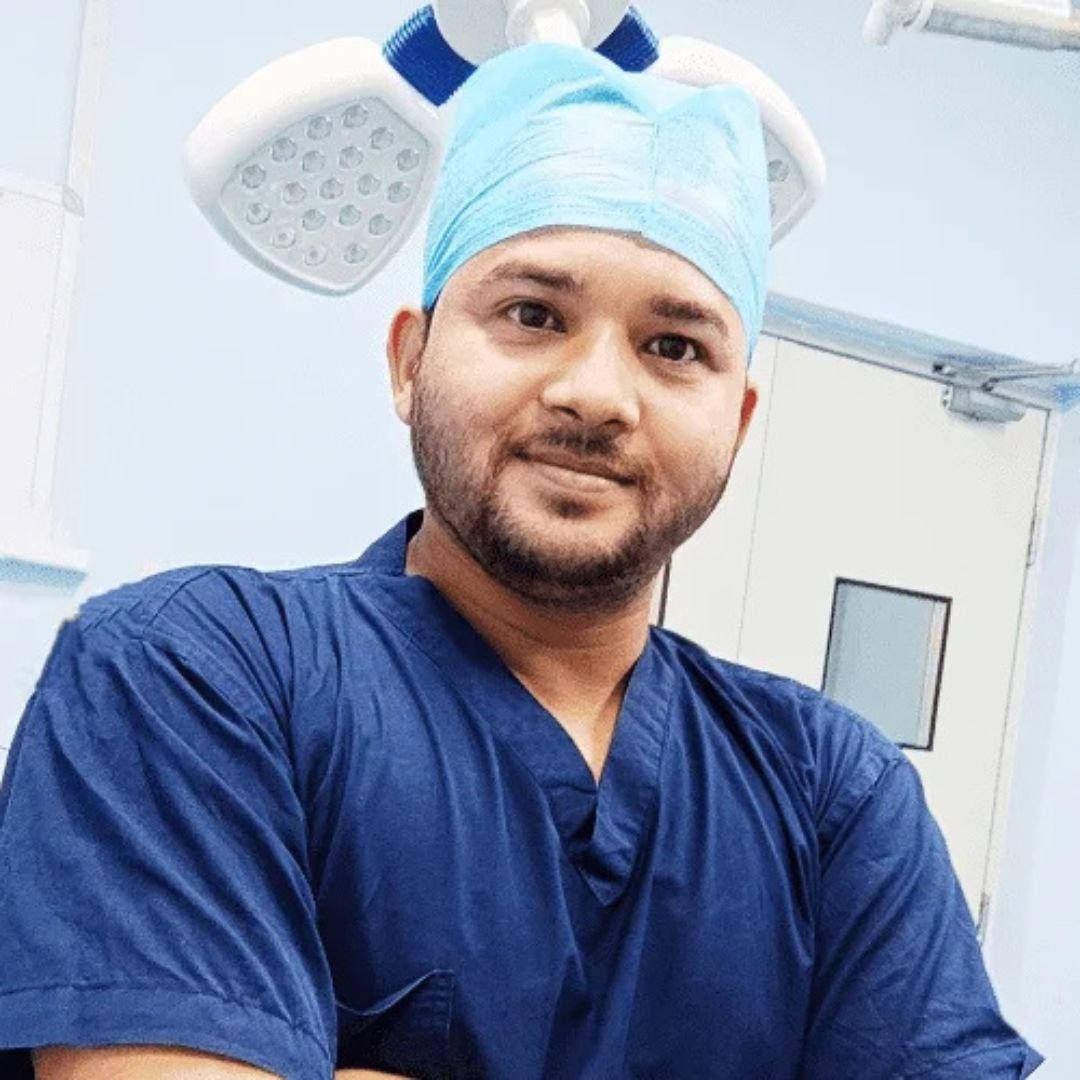Cataract Surgery: Advanced Treatment Options & Recovery Guide
Cataracts are one of the most common eye conditions, affecting millions of people worldwide. If left untreated, cataracts can lead to significant vision impairment or even blindness. Fortunately, modern medical advancements have made cataract surgery one of the safest and most effective procedures to restore clear vision. At Bharatkare, we provide state-of-the-art cataract surgery options, including laser cataract surgery, to help you regain your quality of life.
Whether you’re exploring cataract surgery cost, curious about the best lens for cataract surgery, or seeking information on cataract treatment without surgery, this comprehensive guide covers everything you need to know.
Book Appointments With Our Expert Doctors Near You
- Get consultation for 50+ diseases across India
- In-person and online consultation with experienced doctors
- Extensive medical assistance throughout your treatment


Dr Ashish Sachdeva
MBBS, MS - General Surgery, General Surgeon, Bariatric Surgeon, Laparoscopic Surgeon
4.9/5
20 Years Experience
Vadodara, India

Dr. Tanmay Jain
General Surgeon, Laparoscopic Surgeon and Proctologist
4.9/5
12 Years Experience
Jaipur, India

Dr. Vikram Vasuniya
MBBS, MS (General Surgery) General Laparoscopic & Laser Surgeon, Laser Proctologist
4.9/5
14 Years Experience
Bhopal, India

Dr. Sujeet Kumar Bharti
MBBS, MS (General Surgery) General Laparoscopic & Laser Surgeon, Laser Proctologist
4.9/5
22 Years Experience
Patna, India
What Are Cataracts ?
Cataracts occur when the natural lens of the eye becomes cloudy, leading to blurred or dim vision. This condition is often age-related but can also result from injury, diabetes, or prolonged exposure to UV rays. Common symptoms include:
- Blurred or foggy vision
- Difficulty seeing at night
- Sensitivity to light and glare
- Fading or yellowing of colors
- Frequent changes in eyeglass prescription
Cataracts develop gradually, and in the early stages, symptoms can often be managed with stronger lighting or prescription glasses. However, as the condition progresses, cataract surgery becomes the most effective solution to restore vision.
Disease name
Cataract
Surgery name
Phacoemulsification
Duration
4 weeks
Treated by
Ophthalmologist
Types of Cataracts
Cataracts can be classified based on their location and cause. Understanding the type of cataract is crucial for determining the best treatment approach.
- Nuclear Cataracts:
- Form in the center of the lens and are most commonly associated with aging.
- Symptoms include difficulty seeing distant objects and a temporary improvement in near vision (known as “second sight”).
- Cortical Cataracts:
- Develop in the lens cortex and appear as wedge-shaped opacities.
- Symptoms include glare, halos around lights, and difficulty with contrast.
- Posterior Subcapsular Cataracts:
- Form at the back of the lens and progress rapidly.
- Common in individuals with diabetes or those taking high doses of steroid medications.
- Symptoms include difficulty reading and sensitivity to bright light.
- Congenital Cataracts:
- Present at birth or develop during childhood.
- Often caused by genetic factors or infections during pregnancy.
Can Cataracts Be Treated Without Surgery?
Many patients wonder if cataract cure without surgery is possible. While there is no proven non-surgical method to eliminate cataracts, certain measures can help manage symptoms in the early stages:
- Prescription Glasses: Stronger lenses can improve vision temporarily.
- Anti-Glare Sunglasses: Reduce sensitivity to light and improve comfort outdoors.
- Brighter Lighting: Enhances visibility for reading and other close-up tasks.
- Healthy Diet: Foods rich in antioxidants, such as leafy greens and fruits, may slow cataract progression.
However, these methods only provide temporary relief. For a permanent solution, cataract removal without surgery is not feasible. Cataract surgery remains the only effective treatment to restore clear vision.
Types of Cataract Surgery
There are several types of cataract surgery, each tailored to the patient’s specific needs. The most common procedures include:
- Phacoemulsification Cataract Surgery:
- The most widely performed technique.
- Involves using ultrasound waves to break up the cloudy lens, which is then removed through a small incision.
- A clear intraocular lens (IOL) is implanted to replace the natural lens.
- Known for its quick recovery time and minimal discomfort.
- Laser Cataract Surgery:
- A more advanced and precise method.
- Uses a femtosecond laser to create incisions and soften the cataract for easier removal.
- Offers enhanced accuracy, especially for patients with astigmatism.
- Laser cataract surgery cost is higher than traditional methods but provides superior outcomes.
- Extracapsular Cataract Surgery:
- Recommended for advanced cataracts where the lens is too dense for phacoemulsification.
- Involves removing the cloudy lens in one piece through a larger incision.
- Requires a longer recovery period compared to other techniques.
Best Lens for Cataract Surgery
Choosing the right intraocular lens (IOL) is a critical aspect of cataract surgery. The best lens for cataract surgery depends on your lifestyle, visual needs, and budget. Here are the most common types of IOLs:
Lens Type | Description | Best For |
Monofocal IOLs | Provide clear vision at one distance (usually distance vision). | Patients who don’t mind wearing glasses for near or intermediate tasks. |
Multifocal IOLs | Offer clear vision at multiple distances (near, intermediate, and far). | Patients who want to reduce dependence on glasses after surgery. |
Toric IOLs | Correct astigmatism in addition to cataracts. | Patients with significant astigmatism. |
Accommodating IOLs | Mimic the natural flexibility of the eye’s lens, providing a range of vision. | Patients seeking a more natural visual experience. |
Your ophthalmologist will help you select the best lens for cataract surgery based on your specific requirements.
Cataract Surgery Steps
Understanding the cataract surgery steps can help alleviate any anxiety about the procedure. Here’s a step-by-step breakdown:
- Pre-Surgery Evaluation:
- Comprehensive eye exam to assess the severity of the cataract.
- Measurements of the eye to determine the correct IOL power.
- Anesthesia:
- Local anesthesia is administered to numb the eye.
- Sedatives may be given to help you relax.
- Incision:
- A small incision is made in the cornea (for phacoemulsification) or created using a laser (for laser cataract surgery).
- Cataract Removal:
- The cloudy lens is broken up and removed using ultrasound or laser energy.
- IOL Implantation:
- A clear artificial lens is inserted into the lens capsule.
- Recovery:
- The incision is self-sealing and typically requires no stitches.
- You’ll be monitored for a short period before being discharged.
The entire procedure usually takes 15-30 minutes and is performed on an outpatient basis.
Precautions After Cataract Surgery
Recovering from cataract surgery is typically quick and straightforward, but following proper precautions after cataract surgery is essential to ensure optimal healing and avoid complications. Here’s a detailed guide on what to do (and avoid) post-surgery:
Immediate Post-Surgery Care
- Rest and Relaxation:
- Avoid strenuous activities, heavy lifting, or bending over for at least a week.
- Rest your eyes as much as possible to promote healing.
- Use Prescribed Eye Drops:
- Your doctor will prescribe antibiotic and anti-inflammatory eye drops after cataract surgery to prevent infection and reduce inflammation.
- Follow the dosage instructions carefully.
- Protect Your Eyes:
- Wear the protective eye shield provided by your doctor, especially while sleeping, to avoid accidental rubbing or pressure on the eye.
- Use sunglasses outdoors to protect your eyes from bright light and UV rays.
- Avoid Water and Irritants:
- Keep water, soap, and shampoo away from your eyes for at least a week.
- Avoid swimming or using hot tubs for a few weeks.
- Limit Screen Time:
- Minimize the use of computers, smartphones, and TVs for the first few days to reduce eye strain.
Long-Term Precautions
- Attend Follow-Up Appointments:
- Regular check-ups with your ophthalmologist are crucial to monitor healing and address any concerns.
- Avoid Rubbing Your Eyes:
- Rubbing your eyes can increase the risk of infection or dislodging the intraocular lens (IOL).
- Be Cautious with Physical Activities:
- Avoid contact sports or activities that could result in eye injury for at least a month.
- Gradually resume light exercises after consulting your doctor.
- Watch for Warning Signs:
- Contact your doctor immediately if you experience severe pain, sudden vision loss, increased redness, or flashes of light.
Cataract Surgery Cost in India
When considering cataract surgery, one of the most common questions is about the cataract surgery cost in India. While the exact cost can vary depending on several factors, it’s important to understand what influences the pricing:
- Type of Surgery:
- Phacoemulsification cataract surgery is generally more affordable than laser cataract surgery.
- Advanced techniques like laser cataract surgery may have a higher cost due to the use of specialized equipment.
- Choice of Intraocular Lens (IOL):
- Standard monofocal lenses are more economical, while premium lenses like multifocal or toric IOLs can increase the overall cost.
- Hospital or Clinic Facilities:
- The reputation and infrastructure of the healthcare facility can impact the cost.
- Surgeon’s Expertise:
- Experienced surgeons may charge higher fees for their services.
- Geographical Location:
- The cataract surgery cost in Delhi or other metropolitan cities may differ from smaller towns due to varying operational costs.
- The cataract surgery cost in Delhi or other metropolitan cities may differ from smaller towns due to varying operational costs.
At Bharatkare, we strive to provide transparent and affordable options for cataract surgery. To get a detailed estimate tailored to your needs, feel free to contact us for a consultation.
Cataract Surgery Cost in Delhi
Delhi is a hub for advanced medical treatments, including cataract surgery. The cataract surgery cost in Delhi is influenced by factors such as the type of procedure, the hospital’s reputation, and the surgeon’s expertise.
For instance, laser cataract surgery cost in India may be higher in Delhi compared to smaller cities, but the availability of cutting-edge technology and highly skilled surgeons makes it a preferred choice for many patients.
If you’re considering cataract surgery in Delhi, it’s advisable to compare options and choose a facility that offers a balance of quality and affordability.
Dry Eye Following Cataract Surgery
Dry eye following cataract surgery is a common side effect that many patients experience. This occurs because the surgery can temporarily disrupt the eye’s tear film, leading to symptoms like:
- Dryness or grittiness in the eye
- Redness and irritation
- Blurred vision
- Sensitivity to light
Managing Dry Eye After Surgery
- Use Artificial Tears:
- Over-the-counter lubricating eye drops can provide relief from dryness.
- Follow Your Doctor’s Advice:
- Use prescribed eye drops after cataract surgery to reduce inflammation and promote healing.
- Stay Hydrated:
- Drink plenty of water to maintain overall hydration.
- Avoid Dry Environments:
- Use a humidifier at home to add moisture to the air.
- Limit Screen Time:
- Take regular breaks when using digital devices to prevent eye strain.
- Take regular breaks when using digital devices to prevent eye strain.
In most cases, dry eye following cataract surgery resolves within a few weeks. However, if symptoms persist, consult your ophthalmologist for further evaluation.
Red Eye After Cataract Surgery
Red eye after cataract surgery is another common occurrence and is usually a result of minor inflammation or irritation. While it’s typically not a cause for concern, it’s important to monitor the condition and seek medical advice if necessary.
Causes of Red Eye After Surgery
- Inflammation:
- The eye may appear red due to mild inflammation caused by the procedure.
- Subconjunctival Hemorrhage:
- A small blood vessel may break during surgery, causing a red patch on the white of the eye. This is harmless and resolves on its own.
- Infection:
- Although rare, redness accompanied by pain or discharge could indicate an infection.
When to Seek Help
- If redness persists for more than a week.
- If you experience severe pain, vision loss, or discharge.
- If the redness worsens over time.
Best Hospital for Cataract Surgery
Choosing the best hospital for cataract surgery is crucial for a successful outcome. Here are some factors to consider when selecting a facility:
- Reputation and Expertise:
- Look for hospitals with a proven track record in ophthalmology and cataract surgery.
- Advanced Technology:
- Ensure the hospital is equipped with modern technology, such as femtosecond lasers for laser cataract surgery.
- Experienced Surgeons:
- The skill and experience of the surgeon play a significant role in the success of the procedure.
- Patient Reviews:
- Read testimonials and reviews from previous patients to gauge the quality of care.
- Post-Surgery Support:
- Choose a hospital that offers comprehensive follow-up care and support.
- Choose a hospital that offers comprehensive follow-up care and support.
At Bharatkare, we partner with some of the best hospitals for cataract surgery to ensure our patients receive top-notch care.
Cataract Treatment Without Surgery
While cataract surgery is the most effective way to restore vision, some patients may explore cataract treatment without surgery in the early stages or if they are not suitable candidates for surgery. Here are some non-surgical approaches to manage cataracts:
1. Lifestyle Modifications
- Healthy Diet:
- Consuming foods rich in antioxidants, such as leafy greens, carrots, and citrus fruits, may help slow cataract progression.
- Include omega-3 fatty acids (found in fish and flaxseeds) to support overall eye health.
- UV Protection:
- Wear sunglasses with 100% UV protection to shield your eyes from harmful ultraviolet rays, which can accelerate cataract formation.
- Quit Smoking:
- Smoking is a significant risk factor for cataracts. Quitting can help reduce the progression of the condition.
2. Vision Aids
- Prescription Glasses:
- Stronger eyeglasses or contact lenses can improve vision temporarily.
- Anti-glare coatings on lenses can reduce sensitivity to light.
- Magnifying Lenses:
- Useful for reading or performing close-up tasks.
- Brighter Lighting:
- Enhance visibility in your home or workspace to reduce strain on your eyes.
3. Medications
- Eye Drops:
- While no eye drops can cure cataracts, some products claim to slow their progression. Consult your doctor before using any such products.
- Nutritional Supplements:
- Supplements containing vitamins C and E, lutein, and zeaxanthin may support eye health, though their effectiveness in treating cataracts is not proven.
- Supplements containing vitamins C and E, lutein, and zeaxanthin may support eye health, though their effectiveness in treating cataracts is not proven.
It’s important to note that cataract cure without surgery is not possible. These measures can only help manage symptoms temporarily. If your vision impairment affects your daily life, cataract surgery remains the best option.
Food Not to Eat After Cataract Surgery
Proper nutrition plays a vital role in recovery after cataract surgery. While there are no strict dietary restrictions, certain foods should be avoided to promote healing and prevent complications. Here’s a list of food not to eat after cataract surgery:
- Spicy Foods:
- Spicy foods can cause irritation or discomfort, especially if you experience dry eye following cataract surgery.
- Processed and Junk Foods:
- High in unhealthy fats and low in nutrients, these foods can slow down the healing process.
- Sugary Foods and Beverages:
- Excess sugar can lead to inflammation and weaken the immune system, delaying recovery.
- Caffeinated Drinks:
- Coffee, tea, and energy drinks can contribute to dehydration, which may worsen dry eye following cataract surgery.
- Alcohol:
- Alcohol can dehydrate the body and interfere with the effectiveness of medications prescribed after surgery.
- Foods High in Sodium:
- Excessive salt intake can lead to fluid retention and increased eye pressure, which is not ideal during recovery.
Recommended Foods for Recovery
- Fruits and Vegetables:
- Rich in vitamins and antioxidants, they support healing and overall eye health.
- Lean Proteins:
- Chicken, fish, and legumes provide essential nutrients for tissue repair.
- Whole Grains:
- Brown rice, oats, and quinoa are excellent sources of fiber and energy.
- Hydrating Foods:
- Cucumbers, watermelon, and oranges help maintain hydration levels.
Cooking After Cataract Surgery
After cataract surgery, it’s important to take precautions while cooking after cataract surgery to avoid straining your eyes or exposing them to irritants. Here are some tips:
- Avoid Smoke and Steam:
- Steam from cooking can irritate your eyes. Use lids on pots and pans to minimize exposure.
- Wear Protective Eyewear:
- If you must cook, wear protective glasses to shield your eyes from splatters and fumes.
- Use Adequate Lighting:
- Ensure your kitchen is well-lit to reduce eye strain.
- Take Breaks:
- Avoid spending long hours in the kitchen. Take frequent breaks to rest your eyes.
- Ask for Help:
- If possible, delegate cooking tasks to family members or friends during the initial recovery period.
Types of Lenses for Cataract Surgery
Choosing the right intraocular lens (IOL) is a critical decision during cataract surgery. The types of lenses for cataract surgery vary based on their design and functionality. Here’s a detailed comparison:
Lens Type | Description | Benefits |
Monofocal IOLs | Provide clear vision at one distance (usually distance vision). | – Most affordable option. – Reliable and widely used. |
Multifocal IOLs | Offer clear vision at multiple distances (near, intermediate, and far). | – Reduces dependence on glasses. – Ideal for active lifestyles. |
Toric IOLs | Correct astigmatism in addition to cataracts. | – Improves vision for patients with astigmatism. – Reduces need for glasses. |
Accommodating IOLs | Mimic the natural flexibility of the eye’s lens, providing a range of vision. | – Offers a more natural visual experience. – Suitable for various tasks. |
Your ophthalmologist will help you choose the best lens for cataract surgery based on your visual needs and lifestyle.
What Are the 3 Types of Cataract Surgery?
There are three primary types of cataract surgery, each with its own advantages:
- Phacoemulsification Cataract Surgery:
- The most common and advanced technique.
- Uses ultrasound waves to break up the cloudy lens, which is then removed through a small incision.
- A clear IOL is implanted to replace the natural lens.
- Known for its quick recovery and minimal discomfort.
- Laser Cataract Surgery:
- A more precise and advanced method.
- Uses a femtosecond laser to create incisions and soften the cataract for easier removal.
- Offers enhanced accuracy, especially for patients with astigmatism.
- Laser cataract surgery cost is higher but provides superior outcomes.
- Extracapsular Cataract Surgery:
- Recommended for advanced cataracts where the lens is too dense for phacoemulsification.
- Involves removing the cloudy lens in one piece through a larger incision.
- Requires a longer recovery period compared to other techniques.
- Phacoemulsification Cataract Surgery:
Recovery Tips After Cataract Surgery
To ensure a smooth recovery and optimal results, follow these precautions after cataract surgery:
- Use Prescribed Eye Drops:
- Follow your doctor’s instructions for using antibiotic and anti-inflammatory eye drops after cataract surgery.
- Avoid Rubbing Your Eyes:
- Rubbing can increase the risk of infection or dislodging the IOL.
- Wear Protective Eyewear:
- Use the eye shield provided by your doctor, especially while sleeping, to protect your eyes.
- Limit Screen Time:
- Reduce the use of digital devices to avoid eye strain during the initial recovery period.
- Stay Hydrated:
- Drink plenty of water to support overall healing.
- Avoid Strenuous Activities:
- Refrain from heavy lifting, bending over, or vigorous exercise for at least a week.
- Attend Follow-Up Appointments:
- Regular check-ups are essential to monitor your progress and address any concerns.
- Maintain a Healthy Diet:
- Eat nutrient-rich foods to support healing and overall eye health.
Cataract Surgery and Dry Eye Management
Dry eye following cataract surgery is a common but temporary side effect. Here’s how to manage it:
- Use Artificial Tears:
- Over-the-counter lubricating eye drops can provide relief from dryness.
- Follow Your Doctor’s Advice:
- Use prescribed eye drops after cataract surgery to reduce inflammation and promote healing.
- Avoid Dry Environments:
- Use a humidifier at home to add moisture to the air.
- Blink Regularly:
- Make a conscious effort to blink more often, especially when using digital devices.
- Stay Hydrated:
- Drink plenty of water to maintain overall hydration.
Red Eye After Cataract Surgery: What to Do?
Red eye after cataract surgery is usually a result of minor inflammation or irritation. Here’s how to address it:
- Use Prescribed Eye Drops:
- Follow your doctor’s instructions for using anti-inflammatory eye drops after cataract surgery.
- Apply Cold Compresses:
- Gently place a cold compress on your closed eyelids to reduce redness and swelling.
- Avoid Irritants:
- Stay away from smoke, dust, and other irritants that can worsen redness.
- Monitor Symptoms:
- If redness persists or is accompanied by pain or vision loss, contact your doctor immediately.
Best Hospital for Cataract Surgery: How to Choose?
Selecting the best hospital for cataract surgery is crucial for a successful outcome. Here are some factors to consider:
- Reputation and Expertise:
- Look for hospitals with a proven track record in ophthalmology and cataract surgery.
- Advanced Technology:
- Ensure the hospital is equipped with modern technology, such as femtosecond lasers for laser cataract surgery.
- Experienced Surgeons:
- The skill and experience of the surgeon play a significant role in the success of the procedure.
- Patient Reviews:
- Read testimonials and reviews from previous patients to gauge the quality of care.
- Post-Surgery Support:
- Choose a hospital that offers comprehensive follow-up care and support.
- Choose a hospital that offers comprehensive follow-up care and support.
At Bharatkare, we partner with some of the best hospitals for cataract surgery to ensure our patients receive top-notch care.
Long-Term Care After Cataract Surgery
After recovering from cataract surgery, it’s important to maintain good eye health to preserve your vision and prevent future issues. Here are some long-term care tips:
- Regular Eye Check-Ups:
- Schedule annual eye exams to monitor your vision and overall eye health.
- Protect Your Eyes from UV Rays:
- Wear sunglasses with 100% UV protection to shield your eyes from harmful sunlight.
- Maintain a Healthy Diet:
- Continue eating foods rich in antioxidants, such as leafy greens, carrots, and berries, to support eye health.
- Stay Hydrated:
- Drink plenty of water to keep your eyes lubricated and reduce the risk of dry eye following cataract surgery.
- Avoid Smoking:
- Smoking increases the risk of eye diseases, including macular degeneration and cataracts.
- Manage Chronic Conditions:
- If you have diabetes or high blood pressure, keep them under control to prevent complications that could affect your vision.
- Use Proper Lighting:
- Ensure your home and workspace are well-lit to reduce eye strain.
Myths and Facts About Cataracts
There are many misconceptions about cataracts and cataract surgery. Let’s debunk some common myths:
Myth 1: Cataracts can be cured with eye drops.
Fact: There is no proven cataract cure without surgery. While eye drops may help manage symptoms temporarily, surgery is the only effective treatment.
Myth 2: Cataracts only affect older adults.
Fact: While cataracts are more common in older adults, they can also occur in younger people due to injury, diabetes, or genetic factors.
Myth 3: Cataract surgery is risky and painful.
Fact: Cataract surgery is one of the safest and most effective surgical procedures. It is virtually painless, and complications are rare.
Myth 4: Cataracts can grow back after surgery.
Fact: Once the cloudy lens is removed, cataracts cannot return. However, some patients may experience posterior capsule opacification (PCO), which is easily treatable.
Myth 5: You don’t need to wear sunglasses after cataract surgery.
Fact: Protecting your eyes from UV rays is essential even after surgery to maintain good eye health.
Why Choose Bharatkare for Cataract Surgery?
At Bharatkare, we are committed to providing the highest standard of care for cataract surgery. Here’s why patients trust us:
- Experienced Surgeons:
- Our team of ophthalmologists has extensive experience in performing cataract surgery using advanced techniques.
- State-of-the-Art Technology:
- We use cutting-edge technology, including laser cataract surgery, to ensure precise and effective treatment.
- Personalized Care:
- We tailor our treatment plans to meet the unique needs of each patient, ensuring the best possible outcomes.
- Comprehensive Support:
- From pre-surgery consultations to post-surgery follow-ups, we provide end-to-end support for our patients.
- Affordable Options:
- We offer transparent pricing and flexible payment plans to make cataract surgery accessible to everyone.
Conclusion
Cataracts are a common but treatable condition that can significantly impact your quality of life. With advancements in medical technology, cataract surgery has become a safe, effective, and life-changing procedure. Whether you’re exploring cataract surgery cost, considering laser cataract surgery, or seeking information on cataract treatment without surgery, this guide has covered everything you need to know.
At Bharatkare, we are dedicated to helping you achieve clear vision and improved eye health. If you’re ready to take the next step, contact us today to schedule a consultation and learn more about your options.
FAQ
You Can Find All Answers Here
No, cataracts cannot return once the cloudy lens has been removed. However, some patients may experience a condition called posterior capsule opacification (PCO), where the lens capsule becomes cloudy. This can be easily treated with a quick laser procedure called YAG capsulotomy.
Most patients notice improved vision within a few days, but full recovery can take 4-6 weeks. Follow your doctor’s precautions after cataract surgery to ensure a smooth recovery.
No, cataract surgery is virtually painless. Local anesthesia is used to numb the eye, and patients may feel slight pressure during the procedure. Post-surgery discomfort is usually mild and can be managed with prescribed medications.
Typically, cataract surgery is performed on one eye at a time, with a gap of a few weeks between procedures. This allows the first eye to heal and ensures stability before treating the second eye.
While cataract surgery is considered safe, potential risks include infection, bleeding, swelling, or retinal detachment. These complications are rare and can be minimized by choosing an experienced surgeon and following precautions after cataract surgery.
You should avoid driving until your doctor confirms that your vision meets the legal standard for driving. This usually takes a few days to a week.
Most patients can resume light activities within a day or two. However, avoid strenuous activities, heavy lifting, or bending over for at least a week.
It depends on the type of intraocular lens (IOL) you choose. Monofocal lenses typically require glasses for near vision, while multifocal or accommodating lenses can reduce dependence on glasses.
Cataract surgery has a success rate of over 98%, making it one of the safest and most effective surgical procedures.
While there is no proven cataract cure without surgery, early-stage symptoms can be managed with stronger glasses, brighter lighting, and lifestyle changes. However, surgery is the only permanent solution.
Quick Links
Popular Surgeries
Find Us
© Copyright BharatKare 2025. All Right Reserved.



